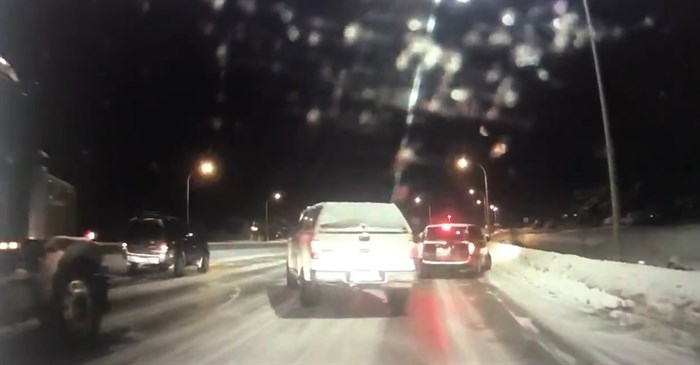
This was just one of the horrible scenes awaiting drivers Sunday, Jan. 12. Heading toward the Glenrosa exit on Highway 97, semis were at a standstill.
Image Credit: FACEBOOK/Glenrosa Shop and Talk
January 13, 2020 - 10:46 AM
If you were one of the people who stayed home as temperatures plunged below 0 C Sunday, you may not have realized how treacherous the roads became.
From one end of the Southern Interior to the other, there were numerous reports of cars skating through intersections, with brake lights indicating other intentions.
RCMP closed off roads in both West Kelowna and Kelowna. Particularly dangerous spots were Rutland’s Highway 33, Boucherie Road in West Kelowna, Highway 97 between West Kelowna and Peachland.
On a Glenrosa community group there was a video of a truck trying to get up the hill toward the Glenrosa turnoff.
In that video the driver passes a semi that had spun out and parked in the middle of the highway while another three cars had parked on the right side of the road.
RCMP were seen throughout the region, blocking particularly dangerous roads and dealing with crashes. An update on how many incidents they dealt with has been requested.
Really, though, the conditions are still pretty unpleasant and road crews are "actively sanding."
"The crews worked through the night to keep all the highways open within both Service Areas. Currently all highways are compact, slippery with icy sections and drifted snow in the valley bottoms. Crews are actively sanding all routes. Temperatures are too cold for salt to be effective," AIM Roads, which conducts maintenance, said in a statement this morning, Jan. 13.
They have been communicating with the School Districts throughout the night and this morning. Most bus routes should be open and buses should be running. They have also be working with municipalities and emergency services to maintain access and to co-ordinate snow response.
"We have reports of large snow drifts being reported on various roads, completely blocking access. Crews are out assessing the drifts and mobilizing graders and loaders to clear the drifts," AIM Roads said.
"We ask that you please prioritize calls to immediate safety issues so that crews are able to prioritize and best resource the response to this latest event."
The weather is expected to start to warm by Friday. Should the forecasted temperatures materialize, AIM Roads' plan is to start returning the highways to bare conditions on Thursday.
Temperatures in a number of Okanagan cities plunged below -20 C and it’s going to be worse in other parts the province.
Most of B.C. was placed under an extreme cold, winter storm or Arctic outflow warning on Monday.
If you're outside, you may want to consider some advice from WorkSafeBC, which said between 2015 and 2018, 30 workers in B.C. were injured as a result of cold exposure.
The most common cold-weather injury is frostbite, which can occur quickly in extreme temperatures, especially when wind or wet clothing are factors. Cold stress can also lead to hypothermia, where a worker becomes so cold they lose more heat than their body produces.
“Working in cold conditions can lead to serious injuries if you’re unprepared — frostbite can occur in a matter of minutes without proper clothing and equipment,” Barry Nakahara, senior manager, prevention field services for WorkSafeBC said in a press release.
WorkSafeBC provides the following safety tips for working in cold weather:
-
Wear warm head covering. Most body heat is lost through the head.
-
Layer clothing to allow sweat to escape and trap heat.
-
Protect hands and feet. Wear waterproof boots and always wear gloves or mittens.
-
Pace any vigorous work with scheduled breaks away from the cold. Fatigue is a risk factor in the cold.
-
Stay hydrated. Limit the amount of coffee or tea and avoid alcohol.
-
When possible, heat the working environment. For example, heated shelters help protect construction workers from cold and damp environments.
To contact a reporter for this story, email Kathy Michaels or call 250-718-0428 or email the editor. You can also submit photos, videos or news tips to the newsroom and be entered to win a monthly prize draw.
We welcome your comments and opinions on our stories but play nice. We won't censor or delete comments unless they contain off-topic statements or links, unnecessary vulgarity, false facts, spam or obviously fake profiles. If you have any concerns about what you see in comments, email the editor in the link above.
News from © iNFOnews, 2020